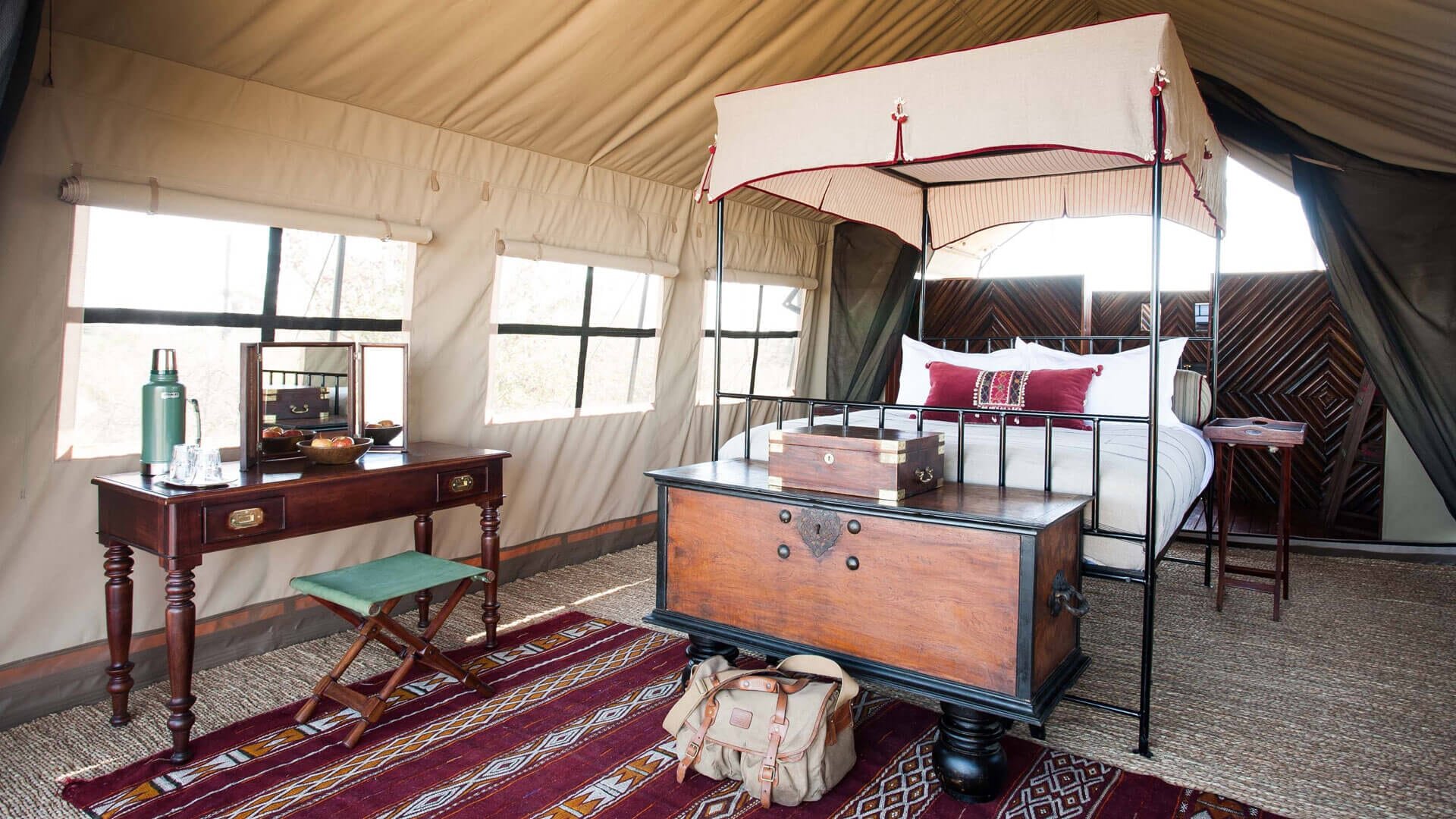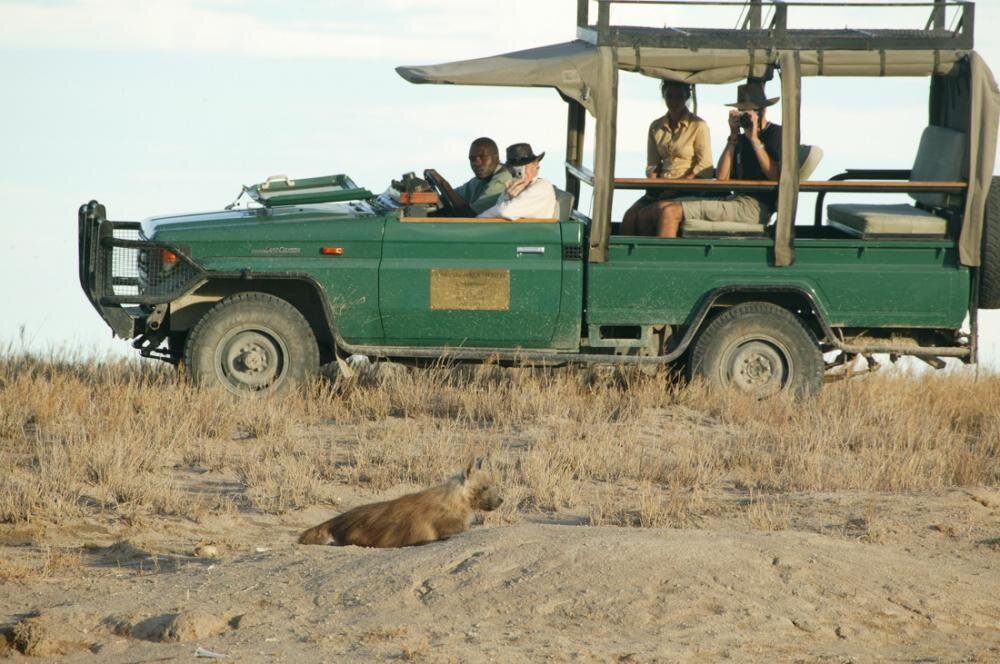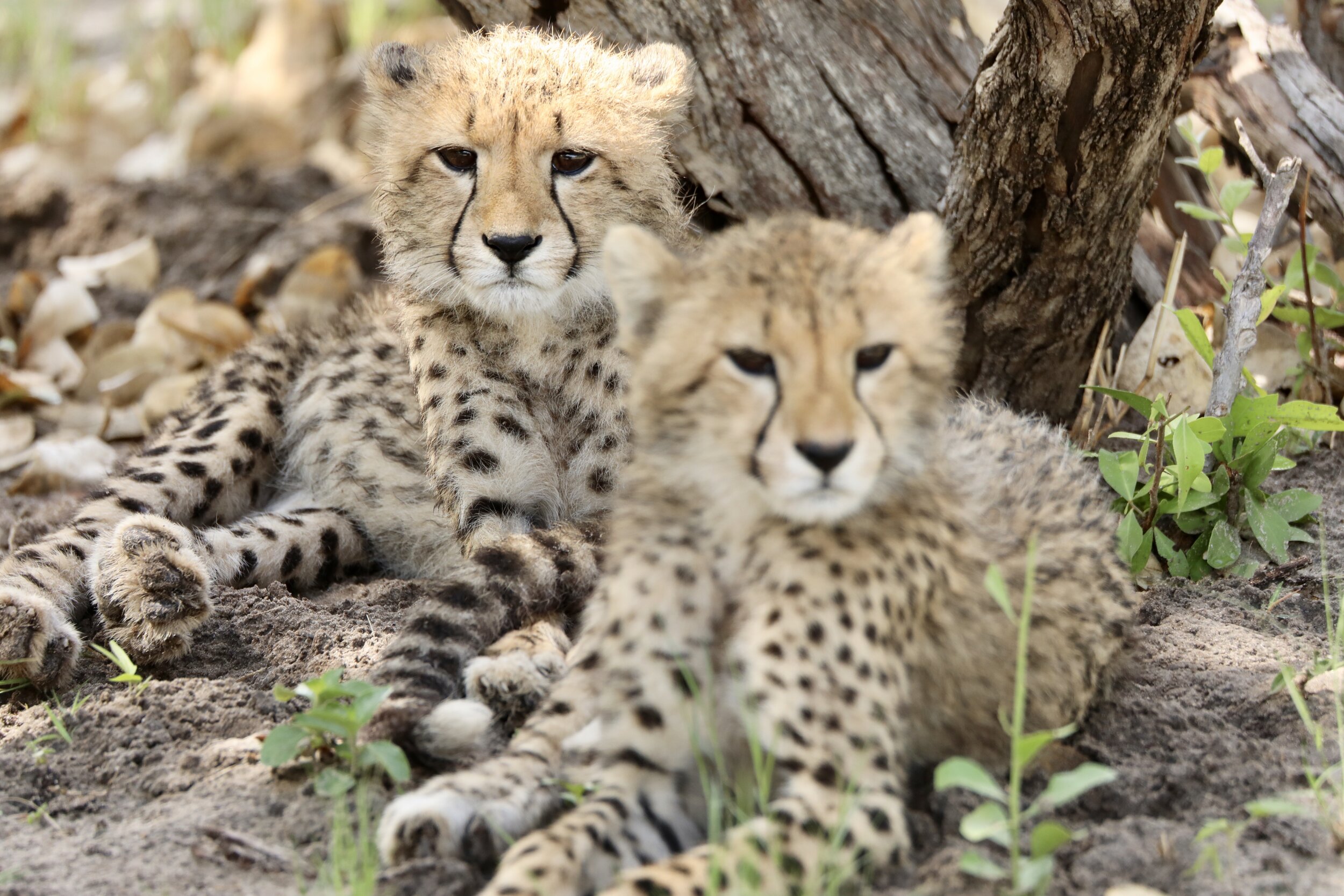The Ultimate Guide to a Luxury Safari in Botswana
An African safari is the ultimate adventure.
A 5:00AM wake up call each morning starts a day in which no one knows how it will go, what you will see, or what you will experience. Rain, wind, migration patterns, and good timing all play an essential role in the experience you’ll have from one day to the next in the Okavango Delta.
With almost any other destination, you select the museums and the sites you’d like to visit, you scope out the restaurant you’d like try, you make a plan, and a lovely day is had by all.
The unpredictability of each game drive was our favorite part of the adventure. Botswana is vast, it is wild, and it presented to us the most unpredictable day-to-day we’ve ever experienced while traveling. We witnessed a female lion hunting, elephants crossing the runway just as our pilot was preparing for take-off, baby cheetah’s devouring a baby impala their mother had just killed for them, two hippos fighting and one subsequently dying, a baby impala learning to walk less than one hour after being born, and a mother and son leopard reuniting in the early hours of the morning.
Each and every day we were reminded that we were in the wild and if that type of adrenaline and adventure speaks to you, consider adding Botswana to your list of upcoming travels. It is an experience like no other we’ve had, and only a few days into our travels, we were already planning a return visit.
Who should travel to Botswana?
Botswana is one of the top safari destinations in Africa, along with Kenya and Tanzania. While these three destinations are all spectacular, they are all very different from one another.
Botswana is unique as it’s the only destination that experiences the flooding of the Okavango Delta. The annual flooding of this river creates a unique landscape that is mostly void of large cities and overcrowded resorts. Botswana will feel large and vast, much different from the more compact East Africa safari destinations.
A safari in Botswana also combines well with neighboring countries. On the border of Zambia and Zimbabwe is Victoria Falls, considered to be the world's largest waterfall due to its width of 1,708 meters. Flights easily connect Botswana to Namibia, a nation of the highest sand dunes on earth and wildlife that has adapted to the desert landscape. Flights from Botswana will also connect easily to South Africa which offers everything from bustling, diverse cities to winelands, fine dining, and a stunning coastline.
Honeymoon in Botswana
A honeymoon in Botswana is perfect for the ultimate adventure couples. While waking up at 5AM and wearing all tones of green and beige day after day is not the most romantic, the luxury lodges are stunning with their private plunge pools and create the most wonderful oasis to return to each afternoon. When planning a honeymoon in Botswana, I highly recommend including time both before and after your safari experience to relax, head to the nearby island destinations or the world famous wineries in South Africa. There are many opportunities to design an itinerary that is both adventurous and romantic in Southern Africa for your honeymoon.
Read more: 5 hidden perks of working with a travel advisor
Adventure Travel in Botswana
A safari in Botswana is absolutely an adventure. To kick it up a notch, consider including Namibia for the desert sand dunes or Zambia for some walking safaris. A hot air balloon during your travels is a must and if you’re really brave, most luxury lodges include a ‘star bed’ where you can have your own private night under the stars, just you and the animals.
Top Tips from my travels in Botswana
Ideally, plan to spend 3 days in each camp. This enables you to get to know the guides, to explore the entirety of the area, increases your chances of seeing the wildlife as many are territorial and are constantly on the move, and provides ample time to enjoy each camp. Moving faster gets exhausting very quickly as it generally takes a half day minimum to move from one camp to another.
In Botswana, be sure to include camps that are all located in vastly different areas with different landscapes. This will ensure your experience doesn’t start to feel repetitive.
I recommend including time both before and after your safari for some “non-safari” experiences, such as visiting a city, the nearby beach destinations, or a luxury lodge where you can relax and spa the day away. This will provide a good mix of experiences for the most balanced itinerary.
The best times to go on safari in Botswana
May to October is usually dry season which is best for wildlife viewing because the trees have less foliage and a shortage of water causes wildlife to congregate at water holes and along the river.
The first rains in mid-December bring out the insects which is fantastic for birding and most antelope species and warthogs are giving birth which an interesting predator - prey dynamic.
Visiting the Makgadikgadi Pans is a great option during the rainy season as this region sees the arrival of large herds of Zebra and Wildebeest which are following an annual migratory pattern driven by the rain and growth of new grass.
While each season offers a unique wildlife experience, traveling from November - March will often offer discounted rates for those looking to stretch their safari budget.
When selecting the best time to visit Botswana, it’s important to work with your travel advisor to discuss your top priorities and general seasonality and how this effects the movement of wildlife and general pricing. Based on your priorities and preferred time of travel, specific lodges can be selected to provide an optimal experience while remaining within your target budget.
How long should I plan to travel in Botswana?
With international travel, a minimum of 10 days will be needed for a Southern Africa safari. 10-14 total travel days is ideal to maximize your time and to not feel rushed.
There are many safari destinations to choose from, all unique in their own way. Botswana offers three distinct experiences in a land the size of Texas with only 2 million people: “boat safaris” (Chobe), a traditional mekoro ride in the Okavango Delta, and the vast, open plains of the Central Kalahari and Magkadikadi Salt Pans where animals have adapted to this harsh environment.
How many days do I need on safari?
Introductory Safari (Great for diverse itineraries and families with young children)
You’ll want 3-4 days minimum on safari. This provides enough time in one location to potentially see all of the wildlife that is covering a very large territory. If including 3-4 days in safari, I recommend staying in one location for the duration of your stay. In addition, any shorter duration would make the logistics to get in and out of the safari camp seem very tiresome and your chances of seeing most wildlife will decrease substantially. Also, if only considering 3-4 total days on safari, I recommend visiting a destination that offers a variety of other experiences to round out the itinerary (South Africa, for example).
Safari Lite (Great for quicker trips, an introductory safari experience, and a diverse itinerary)
4 - 6 days on safari provides the opportunity to stay in two different camps in two different locations. This is beneficial in Botswana as the Chobe River, the Okavango Delta, and the Kalahari all provide drastically different landscapes and wildlife experiences. A 4-6 day safari is recommended if time and/or budget is limited as a safari budget directly correlates with the number of days you’re on safari.
Safari Enthusiast (Most common - when the safari is the main motivation of your trip, once in a lifetime trips)
6 - 9 days on safari is recommended for travelers who are visiting three distinctly different areas and/or you have a keen interest in a particular subject, such as photography or birding. Three distinctly different areas might include Namibia + Okavango Delta + Chobe River or the Ngorongoro Crater + Serengeti + Northern Kenya.










Top Safari Lodges in Botswana: How to choose
Finding the right fit will be to understand the quality and overall experience provided by each camp or lodge. While lodges and camps don’t break down nicely into 3*, 4*, and 5* categories like hotels do, I’ll treat them as if they do for comparison’s sake.
I’ve created a chart below to enable a side by side comparison. Of course, not all lodges and camps that provide really great food or that don’t offer wifi, for example, will fall exactly into the price point below nor will they include the amenities exactly as listed. This chart is meant to serve as a starting point and as a conversation starter to assist when discussing the details of your safari with your travel advisor.
The photos above are from my travels in Botswana where I experienced a stay at all three different styles of camps: an Adventure Camp, two Classic Camps, and three luxury lodges.
Read more: 5 ways a travel advisor can uplevel your next trip
How much does a safari in Botswana cost?
At first glance, an African safari can seem very expensive. So, what’s included in a safari and where does this pricing come from?
First and foremost, there are many components included in a safari that would not be included in a more standard itinerary, to Europe, for example.
Lodges are all inclusive. This includes 3 meals per day and afternoon tea, including most alcohol, complimentary laundry services, your lodging, and all activities during your stay at camp (safari drives, mekoro rides, village visits, etc). Some activities will include a surcharge, such as hot air balloon rides, helicopter rides, etc.
Laundry doesn’t seem necessary, but it very much is! See below for luggage requirements. We had our clothes laundered at every camp along the way.
In Botswana, to travel from one safari camp to another, a charter flight or an overland transfer is required.
National Park entry fees and Conservation fees - imperative to protect and to support the animals and their safety
Components of a safari that are not included but that should also be considered are the following:
Visas / entry fees
Vaccinations / medication
Tips for safari guides and camp staff
What does a typical day on safari look like?
Most camps provide a 5:00AM wake up call, they serve a light breakfast at 5:30AM, and you head out on a game drive by 6:00AM. You’ll enjoy a coffee / tea break while you’re out and will return to the camp anytime between 10 - 11:00AM for brunch.
After brunch, you’ll have a few hours to rest, nap, enjoy the swimming pool, catch up on some reading, take a shower, get a massage, etc. You’ll usually have afternoon tea around 3:30PM and will head out for your second safari drive at 4:00PM.
So, while early morning wake up calls and long hours on safari drive in the morning and afternoon sound exhausting, you do also have a nice chunk of time in the afternoon to relax. On a few days, I took a long, much needed nap. Another day I got a massage and on a few other days, we enjoyed our private plunge pool and had time to read and post some of our favorite photos on social media for our friends and family back home.
Staying safe while on safari in Botswana
Many camps will require someone from their team to escort you to and from your tent / room for early morning game drives and after dinner. As camps are located out in the wild and there are not any fences, it is not unusual for wild animals to approach the camp grounds. Having an experienced guide escort you is for your safety.
How to get to Botswana
A safari in Botswana will most likely take you through South Africa, which is also a fantastic destination to visit. When considering that a safari experience is usually 6 - 9 days maximum, you’ll likely have time to include a visit to Cape Town and/or Johannesburg on your way in to the country and on your way out. This helps to break up those long travels days and adds some variety to your itinerary.
Currently, there are direct flights to Johannesburg, South Africa from Atlanta on Delta Airlines. There are direct flights to Cape Town, South Africa from Newark, NJ on United Airlines. These flights are 15 hours and 14.5 hours respectively. This is a pretty similar flight time from the United States to Asia, as a point of comparison.
Alternatively, flying to Eastern Africa (Kenya or Tanzania), you will most likely connect in Europe. It could be possible to spend a couple days in Europe to take a break en route to Africa.
This may also be a good trip to consider Premium Economy or Business Class flights, both of which we’re happy to assist with.
What other countries should I consider visiting in this region?
A trip to Botswana combines very well with visit to Victoria Falls and can easily combine with neighboring countries such as Zimbabwe, Zambia, Namibia, or South Africa to create a diverse trip with a variety of experiences.
When should I start planning?
If you’re hoping to travel during peak season (May - October), planning one year or more in advance is very important to secure space in your preferred lodges. Many lodges are quite small and sell out quickly.
If you’re planning to travel during shoulder season, planning 8-12 months in advance is usually sufficient.
Of course - the earlier the better!
What to pack for a safari in Botswana
Preparation for a safari will look a lot different than most trips. From the very limited weight restrictions that each traveler is allowed to the recommended colors and insect repellant, this packing list is likely to include many items that you wouldn’t normally travel with.
Weight limits and luggage allowance on safari
The maximum permissible luggage allowance on the light aircraft carriers – including a carry on – is usually around 20 kg (44 lb) per person. These strict guidelines on the light aircraft transfers is due to space restrictions and because these aircraft are designed with a maximum bodyweight and luggage weight allowance.
In addition to these weight restrictions, luggage must be soft sided (no frame or rigid structure). This is specifically due to the compartments where the luggage is stored. The bag must be soft sided to conform to the available space.
It is very important to reconfirm the weight and size restrictions with your safari operator. If your itinerary includes multiple light aircraft carriers, you’ll need to comply with the most restrictive weight and size restrictions to avoid paying extra fees.
Mosquito protection
Mosquito protection during your travels in Africa can come in a variety of forms. Malaria tablets are available from your doctor and should be discussed with a medical professional. There are also many products you can buy such as insect repellant wipes, essential oil wristbands, treated clothing, etc that will help repel mosquitos and other pests during your travels. Many of these products have been linked below.
Clothing recommendations
While on safari, it’s important to be mindful of the clothes you’re wearing to not aggravate or disturb the wildlife that you’re there to see. Solid, neutral colors in the brown and green family will be best.
It’s also important to be mindful of the season you’ll be traveling in Africa. In their winter, it can be quite cold, so a scarf, socks, and a jacket will be necessary. During their hotter months, it can be very humid and rainy, so not only paying close attention to the colors you’re packing, you’ll also want breathable fabrics such as linen.
There is a “classic safari” look for a reason! :)
Safari Packing List
insect repellant clothing
Women’s top or hoody
Clothing treatment (we also used this treatment on clothes we already owned)
Camera - a telephoto lens is a must have for photographer enthusiasts. While you’ll be closer than ever to the animals, most shots you see in this post were taken with a telephoto lens
Extra batteries / external charger / extra memory cards
Sunglasses
Sunscreen
Water bottle
Green, brown, beige, and yellow clothing - avoid bright colors and patterns
Comfortable walking shoes / boots (we opted for boots to provide extra mosquito coverage
Soft sided duffel bag






